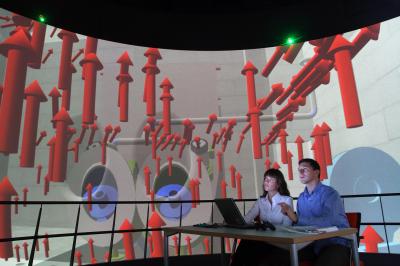Designing a new hydroelectric power station can be a laborious task - the pressures, temperatures and fluid flows can be simulated but the actual results outside FEA showbiz graphics will still be columns of numbers or a one-dimensional representation which need analysis.
A new technique could make the process a lot more elegant. Scientists from the Fraunhofer Institute for Factory Operation and Automation IFF in Magdeburg have developed a method that visualizes the processes inside energy conversion plants, e.g. such as photovoltaic, wind, biogas and hydroelectric power stations. To do so, they have coupled 3-D plant engineering and simulation results with a virtual reality (VR) program developed at the IFF.
There's a bipolar force with a repulsive side that doesn't involve cosmic opera or wooden acting - it's light. And it can be used to control components on silicon microchips, meaning future nanodevices could be controlled by light rather than electricity, according to Yale researchers.
The team previously discovered an 'attractive' force of light and showed how it could be manipulated tiny switches in semiconducting micro- and nano-electrical systems. They say they have now uncovered its non-evil twin - a repulsive force.
University of Denver researchers say that couples who live together before they are engaged have a higher chance of getting divorced than those who wait until they are married to cohabitate.
In addition, couples who lived together before engagement and then married, reported a lower satisfaction in their marriages. Couples who got engaged and then later moved in together had no conclusive difference one way or another. The research published in Journal of Family Psychology was conducted by Galena Rhoades, senior researcher, Scott Stanley, research professor, and Howard Markman, professor of psychology.
Cornell computer scientists say they have tracked and analyzed the "news cycle", the way stories rise and fall in popularity, and found a consistent pattern as stories rose into prominence and then fell off after a few days, with a 'heartbeat' pattern of handoffs between blogs and mainstream media.
In mainstream media, in most cases a story rises to prominence slowly then dies quickly but in the blogosphere, stories rise in popularity very quickly but then stay around longer, as discussion goes back and forth. Every story is eventually pushed aside by something newer.
So blogs may not be taking the place of newspapers and television news as much as magazine features, where more complex stories would usually be fleshed out.
University of Dundee scientists say they have shown that E. coli, one of the most extensively studied organisms in the world, still has some secrets that may hold the key to human diseases, such as cancer.
The team has examined the genome sequence of this workhorse of the laboratory and spotted three previously unknown genes that, it turns out, are essential for the survival of E. coli and one out of the three could also be implicated in cancer or developmental abnormalities in humans. These mystery genes are also found in numerous other creatures, suggesting a vital role for them across many species. The research will be published in the Journal of Bacteriology.
If you have a 'difficult' baby, don't worry too much about your parenting skills. A new report in Psychological Science says that a child's temperament may be due in part to a combination of a certain gene and a specific pattern of brain activity.
The pattern of brain activity in the frontal cortex of the brain has been associated with various types of temperament in children. For example, infants who have more activity in the left frontal cortex are characterized as temperamentally "easy" and can be soothed with less effort. Conversely, infants with greater activity in the right half of the frontal cortex are temperamentally "difficult" and are easily distressed and require more effort to soothe.
 Opioid Addicts Are Less Likely To Use Legal Opioids At The End Of Their Lives
Opioid Addicts Are Less Likely To Use Legal Opioids At The End Of Their Lives More Like Lizards: Claim That T. Rex Was As Smart As Monkeys Refuted
More Like Lizards: Claim That T. Rex Was As Smart As Monkeys Refuted Study: Caloric Restriction In Humans And Aging
Study: Caloric Restriction In Humans And Aging Science Podcast Or Perish?
Science Podcast Or Perish?









